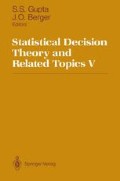Abstract
The randomized response survey model introduced by Warner (1965) is reviewed and applied to the analysis of contaminated data, i. e., response or reported data which is truthful with probability less than one. Two generic mechanisms are distinguished: an active mechanism whereby the contamination is inserted into the process and hence becomes a statistical design parameter, and a passive mechanism whereby contamination of the response is suspected and hence becomes an analysis parameter. The impact of contamination on the operating characteristics of a subset ranking and selection procedure for binomial models is assessed.
The author gratefully acknowledges the valuable contributions of Ms. Diana Wegner in developing the computations for Tables 1-3.
Access this chapter
Tax calculation will be finalised at checkout
Purchases are for personal use only
Preview
Unable to display preview. Download preview PDF.
References
Chaudhuri, A. and Mukerjee, R. (1988). Randomized Response: Theory and Techniques, Marcel Dekker, Inc., New York, N. Y.
Gupta, S. S. and McDonald, G. C. (1986). “A Statistical Selection Approach to Binomial Models.” Journal of Quality Technology 18, 103–115.
Gupta, S. S. and Sobel, M. (1960). “Selecting A Subset Containing the Best of Several Binomial Populations.” Contributions to Probability and Statistics, Stanford University Press, 224–248.
McDonald, G. C. (1993). “Adjusting for Data Contamination in Statistical Inference.” General Motors Research Publication GMR 7304 (Revised).
Moors, J. J. A. (1985). “Estimation in Truncated Parameter Spaces,” Ph.D. Thesis, Kathalieke Hogeschool, Tilburg.
Nathan, G. (1988). “A Bibliography on Randomized Response: 1965–1987.” Survey Methodology 14, 331–346.
Warner, S. L. (1965). “RR: A Survey Technique for Eliminating Evasive Answer Bias.” Journal of the American Statistical Association 60, 63–69.
Wolfram, S. (1988). Mathematica TM — A System for Doing Mathematics by Computer, Addison-Wesley Publishing Co., Inc., Reading, MA.
Author information
Authors and Affiliations
Editor information
Editors and Affiliations
Rights and permissions
Copyright information
© 1994 Springer-Verlag New York, Inc.
About this paper
Cite this paper
McDonald, G.C. (1994). Analyzing Randomized Response Data with a Binomial Selection Procedure. In: Gupta, S.S., Berger, J.O. (eds) Statistical Decision Theory and Related Topics V. Springer, New York, NY. https://doi.org/10.1007/978-1-4612-2618-5_25
Download citation
DOI: https://doi.org/10.1007/978-1-4612-2618-5_25
Publisher Name: Springer, New York, NY
Print ISBN: 978-1-4612-7609-8
Online ISBN: 978-1-4612-2618-5
eBook Packages: Springer Book Archive

